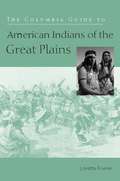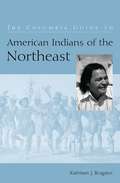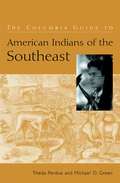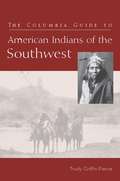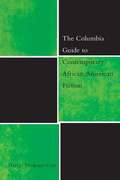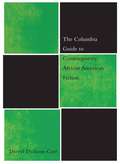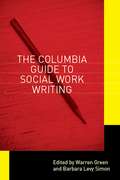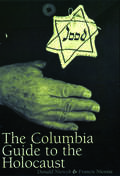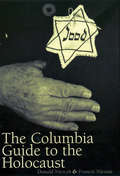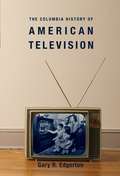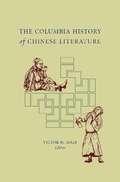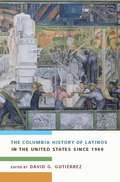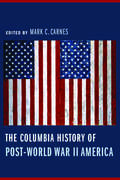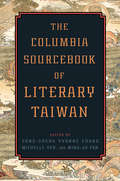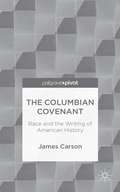- Table View
- List View
The Columbia Guide to American Indians of the Great Plains
by Loretta FowlerHere in one volume is an indispensable guide to the extensive ethnohistorical research that, in recent decades, has recovered the varied and often unexpected history of Comanche, Cheyenne, Osage, and Sioux Indians, to name only a few of the tribal groups included. From the earliest archaeological evidence to the current experience of Indians living on and off reservations, a wealth of information is presented in a clear and accessible way..
The Columbia Guide to American Indians of the Great Plains (The Columbia Guides to American Indian History and Culture)
by Loretta FowlerPlains Indians have long occupied a special place in the American imagination. Both the historical reality of such evocative figures and events as Crazy Horse, Sitting Bull, Sacajewea, and the Battle of Little Bighorn and the lived reality of Native Americans today are often confused and conflated with popular representations of Indians in movies, paintings, novels, and on television. Ingrained stereotypes and cultural misconceptions born of late nineteenth– and early twentieth–century images of the romantic nomad and the marauding savage have been surprisingly tenacious, obscuring the extraordinary cultural and linguistic diversity of the dozens of tribes and nations who have peopled the Great Plains. Here in one volume is an indispensable guide to the extensive ethnohistorical research that, in recent decades, has recovered the varied and often unexpected history of Comanche, Cheyenne, Osage, and Sioux Indians, to name only a few of the tribal groups included. From the earliest archaeological evidence to the current experience of Indians living on and off reservations, a wealth of information is presented in a clear and accessible way. The history of the Plains Indians has been a dynamic one of continuous change and adaptation as groups split and recombined to form new social orders and cultural traditions. Contact with Europeans and the introduction of trade in horses, slaves, furs, and guns dramatically altered native societies internally and influenced relations between different groups. In the face of pressures resulting from America's westward expansion throughout the nineteenth and twentieth centuries—the extinction of the bison, the imposition of reservation life, and the assimilationist policies of the U.S. federal government—the native peoples of the Great Plains have struggled to preserve their distinct cultures and reorient themselves to a new world on their own terms.The Columbia Guide to American Indians of the Great Plains is divided into four parts. Part I presents an overview of the cultures and histories of Plains Indian people and surveys the key scholarly questions and debates that shape this field. Part II serves as an encyclopedia, alphabetically listing important individuals and places of significant cultural or historic meaning. Part III is a chronology of the major events in the history of American Indians in the Plains. The expertly selected resources guide in Part IV includes annotated bibliographies, museum and tribal Internet sites, and films that can be easily accessed by those wishing to learn more.The third in a six-volume reference series, The Columbia Guides to American Indian History and Culture, The Columbia Guide to American Indians of the Great Plains is an invaluable resource for students, teachers, and researchers.
The Columbia Guide to American Indians of the Northeast
by Kathleen J. BragdonAn overview of the cultures and histories of Northeastern Indian people that surveys the key scholarly debates that shape this field and offers an alphabetical listing of important individuals and places of significant cultural or historic meaning.
The Columbia Guide to American Indians of the Northeast (The Columbia Guides to American Indian History and Culture)
by Kathleen BragdonDescriptions of Indian peoples of the Northeast date to the Norse sagas, centuries before permanent European settlement, and the region has been the setting for a long history of contact, conflict, and accommodation between natives and newcomers. The focus of an extraordinarily vital field of scholarship, the Northeast is important both historically and theoretically: patterns of Indian-white relations that developed there would be replicated time and again over the course of American history. Today the Northeast remains the locus of cultural negotiation and controversy, with such subjects as federal recognition, gaming, land claims, and repatriation programs giving rise to debates directly informed by archeological and historical research of the region.The Columbia Guide to American Indians of the Northeast is a concise and authoritative reference resource to the history and culture of the varied indigenous peoples of the region. Encompassing the very latest scholarship, this multifaceted volume is divided into four parts. Part I presents an overview of the cultures and histories of Northeastern Indian people and surveys the key scholarly questions and debates that shape this field. Part II serves as an encyclopedia, alphabetically listing important individuals and places of significant cultural or historic meaning. Part III is a chronology of the major events in the history of American Indians in the Northeast. The expertly selected resources in Part IV include annotated lists of tribes, bibliographies, museums and sites, published sources, Internet sites, and films that can be easily accessed by those wishing to learn more.
The Columbia Guide to American Indians of the Southeast (The Columbia Guides to American Indian History and Culture)
by Michael Green Theda PerdueThough they speak several different languages and organize themselves into many distinct tribes, the Native American peoples of the Southeast share a complex ancient culture and a tumultuous history. This volume examines and synthesizes their history through each of its integral phases: the complex and elaborate societies that emerged and flourished in the Pre-Columbian period; the triple curse of disease, economic dependency, and political instability brought by the European invasion; the role of Native Americans in the inter-colonial struggles for control of the region; the removal of the "Five Civilized Tribes" to Oklahoma; the challenges and adaptations of the post-removal period; and the creativity and persistence of those who remained in the Southeast.
The Columbia Guide to American Indians of the Southwest
by Trudy Griffin-PierceA major work on the history and culture of Southwest Indians, The Columbia Guide to American Indians of the Southwest tells a remarkable story of cultural continuity in the face of migration, displacement, violence, and loss. The Native peoples of the American Southwest are a unique group, for while the arrival of Europeans forced many Native Americans to leave their land behind, those who lived in the Southwest held their ground. Many still reside in their ancestral homes, and their oral histories, social practices, and material artifacts provide revelatory insight into the history of the region and the country as a whole. Trudy Griffin-Pierce incorporates her lifelong passion for the people of the Southwest, especially the Navajo, into an absorbing narrative of pre- and postcontact Native experiences. She finds that, even though the policies of the U.S. government were meant to promote assimilation, Native peoples formed their own response to outside pressures, choosing to adapt rather than submit to external change. Griffin-Pierce provides a chronology of instances that have shaped present-day conditions in the region, as well as an extensive glossary of significant people, places, and events. Setting a precedent for ethical scholarship, she describes different methods for researching the Southwest and cites sources for further archaeological and comparative study. Completing the volume is a selection of key primary documents, literary works, films, Internet resources, and contact information for each Native community, enabling a more thorough investigation into specific tribes and nations.
The Columbia Guide to American Indians of the Southwest (The Columbia Guides to American Indian History and Culture)
by Trudy Griffin-PierceA major work on the history and culture of Southwest Indians, The Columbia Guide to American Indians of the Southwest tells a remarkable story of cultural continuity in the face of migration, displacement, violence, and loss. The Native peoples of the American Southwest are a unique group, for while the arrival of Europeans forced many Native Americans to leave their land behind, those who lived in the Southwest held their ground. Many still reside in their ancestral homes, and their oral histories, social practices, and material artifacts provide revelatory insight into the history of the region and the country as a whole.Trudy Griffin-Pierce incorporates her lifelong passion for the people of the Southwest, especially the Navajo, into an absorbing narrative of pre- and postcontact Native experiences. She finds that, even though the policies of the U.S. government were meant to promote assimilation, Native peoples formed their own response to outside pressures, choosing to adapt rather than submit to external change. Griffin-Pierce provides a chronology of instances that have shaped present-day conditions in the region, as well as an extensive glossary of significant people, places, and events. Setting a precedent for ethical scholarship, she describes different methods for researching the Southwest and cites sources for further archaeological and comparative study. Completing the volume is a selection of key primary documents, literary works, films, Internet resources, and contact information for each Native community, enabling a more thorough investigation into specific tribes and nations.The Columbia Guides to American Indian History and Culture also include:The Columbia Guide to American Indians of the Great PlainsLoretta FowlerThe Columbia Guide to American Indians of the NortheastKathleen J. BragdonThe Columbia Guide to American Indians of the SoutheastTheda Perdue and Michael D. Green
The Columbia Guide to Asian American History (Columbia Guides to American History and Cultures)
by Gary OkihiroOffering a rich and insightful road map of Asian American history as it has evolved over more than 200 years, this book marks the first systematic attempt to take stock of this field of study. It examines, comments, and questions the changing assumptions and contexts underlying the experiences and contributions of an incredibly diverse population of Americans. Arriving and settling in this nation as early as the 1790s, with American-born generations stretching back more than a century, Asian Americans have become an integral part of the American experience; this cleverly organized book marks the trajectory of that journey, offering researchers invaluable information and interpretation. Part 1 offers a synoptic narrative history, a chronology, and a set of periodizations that reflect different ways of constructing the Asian American past. Part 2 presents lucid discussions of historical debates—such as interpreting the anti-Chinese movement of the late 1800s and the underlying causes of Japanese American internment during World War II—and such emerging themes as transnationalism and women and gender issues. Part 3 contains a historiographical essay and a wide-ranging compilation of book, film, and electronic resources for further study of core themes and groups, including Chinese, Japanese, Filipino, Hmong, Indian, Korean, Vietnamese, and others.
The Columbia Guide to Contemporary African American Fiction
by Darryl Dickson-CarrFrom Ishmael Reed and Toni Morrison to Colson Whitehead and Terry McMillan, Darryl Dickson-Carr offers a definitive guide to contemporary African American literature
The Columbia Guide to Contemporary African American Fiction
by Darryl Dickson-CarrThis new reference volume offers an accessible and authoritative guide to the major authors, texts, movements, and ideas that have shaped contemporary African American fiction. In more than 160 concise entries, arranged alphabetically, Dickson-Carr provides a wealth of factual and interpretative information. He discusses the careers, works, and critical receptions of Toni Morrison, Gloria Naylor, Jamaica Kincaid, Charles Johnson, Leon Forrest, and other prominent and lesser known authors. Each entry presents ways of reading the authors' works, identifies key themes and influences, assesses the writers' overarching significance, and includes sources for further research. Dickson-Carr also considers the impact and development of a variety of literary movements, critical theories, and publishers of African American work. The Columbia Guide includes an overview that situates African American fiction in the social, political, and cultural contexts of post-Civil Rights era America. In addition to examining debates regarding the role of literature in African American life, Dickson-Carr considers the influence of hip-hop, the blues, and jazz on African American novelists. The volume concludes with an extensive annotated bibliography of African American fiction and criticism.
The Columbia Guide to Contemporary African American Fiction (The Columbia Guides to Literature Since 1945)
by Darryl Dickson-CarrFrom Ishmael Reed and Toni Morrison to Colson Whitehead and Terry McMillan, Darryl Dickson-Carr offers a definitive guide to contemporary African American literature. This volume-the only reference work devoted exclusively to African American fiction of the last thirty-five years-presents a wealth of factual and interpretive information about the major authors, texts, movements, and ideas that have shaped contemporary African American fiction. In more than 160 concise entries, arranged alphabetically, Dickson-Carr discusses the careers, works, and critical receptions of Alice Walker, Gloria Naylor, Jamaica Kincaid, Charles Johnson, John Edgar Wideman, Leon Forrest, as well as other prominent and lesser-known authors. Each entry presents ways of reading the author's works, identifies key themes and influences, assesses the writer's overarching significance, and includes sources for further research. Dickson-Carr addresses the influence of a variety of literary movements, critical theories, and publishers of African American work. Topics discussed include the Black Arts Movement, African American postmodernism, feminism, and the influence of hip-hop, the blues, and jazz on African American novelists. In tracing these developments, Dickson-Carr examines the multitude of ways authors have portrayed the diverse experiences of African Americans.The Columbia Guide to Contemporary African American Fiction situates African American fiction in the social, political, and cultural contexts of post-Civil Rights era America: the drug epidemics of the 1980s and 1990s and the concomitant "war on drugs," the legacy of the Civil Rights Movement, the struggle for gay rights, feminism, the rise of HIV/AIDS, and racism's continuing effects on African American communities. Dickson-Carr also discusses the debates and controversies regarding the role of literature in African American life. The volume concludes with an extensive annotated bibliography of African American fiction and criticism.
The Columbia Guide to Social Work Writing
by Warren Green Barbara Levy SimonSocial work practitioners write for a variety of publications, and they are expected to show fluency in a number of related fields. Whether the target is a course instructor, scholarly journal, fellowship organization, or general news outlet, social workers must be clear, persuasive, and comprehensive in their writing, especially on provocative subjects. This first-of-its-kind guide features top scholars and educators providing a much-needed introduction to social work writing and scholarship. Foregrounding the process of social work writing, the coeditors particularly emphasize how to think about and approach one's subject in a productive manner. The guide begins with an overview of social work writing from the 1880s to the present, and then follows with ideal strategies for academic paper writing, social work journal writing, and social work research writing. A section on applied professional writing addresses student composition in field education, writing for and about clinical practice, the effective communication of policy information to diverse audiences, program and proposal development, advocacy, and administrative writing. The concluding section focuses on specific fields of practice, including writing on child and family welfare, contemporary social issues, aging, and intervention in global contexts. Grounding their essays in systematic observations, induction and deduction, and a wealth of real-world examples, the contributors describe the conceptualization, development, and presentation of social work writing in ways that better secure its power and relevance.
The Columbia Guide to Social Work Writing
by Warren Green Barbara Levy SimonSocial work practitioners write for a variety of publications, and they are expected to show fluency in a number of related fields. Whether the target is a course instructor, scholarly journal, fellowship organization, or general news outlet, social workers must be clear, persuasive, and comprehensive in their writing, especially on provocative subjects. This first-of-its-kind guide features top scholars and educators providing a much-needed introduction to social work writing and scholarship. Foregrounding the process of social work writing, the coeditors particularly emphasize how to think about and approach one's subject in a productive manner.The guide begins with an overview of social work writing from the 1880s to the present, and then follows with ideal strategies for academic paper writing, social work journal writing, and social work research writing. A section on applied professional writing addresses student composition in field education, writing for and about clinical practice, the effective communication of policy information to diverse audiences, program and proposal development, advocacy, and administrative writing. The concluding section focuses on specific fields of practice, including writing on child and family welfare, contemporary social issues, aging, and intervention in global contexts. Grounding their essays in systematic observations, induction and deduction, and a wealth of real-world examples, the contributors describe the conceptualization, development, and presentation of social work writing in ways that better secure its power and relevance.
The Columbia Guide to the Holocaust
by Niewyk Donald L. Francis R. NicosiaThis invaluable resource provides a multidimensional survey of the Holocaust, essentially integrating five separate books into one comprehensive reference tool: a historical overview; a guide to Holocaust controversies; an A-to-Z encyclopedia of people, places, and terms; a chronology; and a comprehensive resource guide. Whether used separately for their individual merits or approached as an integrated whole, the five sections of this informative volume constitute an indispensable contribution to the study of the Holocaust.
The Columbia Guide to the Holocaust
by Francis R. Nicosia Donald L. NiewykOffering a multidimensional approach to one of the most important episodes of the twentieth century, The Columbia Guide to the Holocaust offers readers and researchers a general history of the Holocaust while delving into the core issues and debates in the study of the Holocaust today.Each of the book's five distinct parts stands on its own as valuable research aids; together, they constitute an integrated whole. Part I provides a narrative overview of the Holocaust, placing it within the larger context of Nazi Germany and World War II. Part II examines eight critical issues or controversies in the study of the Holocaust, including the following questions: Were the Jews the sole targets of Nazi genocide, or must other groups, such as homosexuals, the handicapped, Gypsies, and political dissenters, also be included? What are the historical roots of the Holocaust? How and why did the "Final Solution" come about? Why did bystanders extend or withhold aid?Part III consists of a concise chronology of major events and developments that took place surrounding the Holocaust, including the armistice ending World War I, the opening of the first major concentration camp at Dachau, Germany's invasion of Poland, the failed assassination attempt against Hitler, and the formation of Israel.Part IV contains short descriptive articles on more than two hundred key people, places, terms, and institutions central to a thorough understanding of the Holocaust. Entries include Adolf Eichmann, Anne Frank, the Warsaw Ghetto, Aryanization, the SS, Kristallnacht, and the Catholic Church. Part V presents an annotated guide to the best print, video, electronic, and institutional resources in English for further study.Armed with the tools contained in this volume, students or researchers investigating this vast and complicated topic will gain an informed understanding of one of the greatest tragedies in world history.
The Columbia Guide to the Holocaust
by Francis R. Nicosia Donald L. NiewykOffering a multidimensional approach to one of the most important episodes of the twentieth century, The Columbia Guide to the Holocaust offers readers and researchers a general history of the Holocaust while delving into the core issues and debates in the study of the Holocaust today.Each of the book's five distinct parts stands on its own as valuable research aids; together, they constitute an integrated whole. Part I provides a narrative overview of the Holocaust, placing it within the larger context of Nazi Germany and World War II. Part II examines eight critical issues or controversies in the study of the Holocaust, including the following questions: Were the Jews the sole targets of Nazi genocide, or must other groups, such as homosexuals, the handicapped, Gypsies, and political dissenters, also be included? What are the historical roots of the Holocaust? How and why did the "Final Solution" come about? Why did bystanders extend or withhold aid?Part III consists of a concise chronology of major events and developments that took place surrounding the Holocaust, including the armistice ending World War I, the opening of the first major concentration camp at Dachau, Germany's invasion of Poland, the failed assassination attempt against Hitler, and the formation of Israel.Part IV contains short descriptive articles on more than two hundred key people, places, terms, and institutions central to a thorough understanding of the Holocaust. Entries include Adolf Eichmann, Anne Frank, the Warsaw Ghetto, Aryanization, the SS, Kristallnacht, and the Catholic Church. Part V presents an annotated guide to the best print, video, electronic, and institutional resources in English for further study.Armed with the tools contained in this volume, students or researchers investigating this vast and complicated topic will gain an informed understanding of one of the greatest tragedies in world history.
The Columbia History of American Television
by Gary EdgertonTelevision is a form of media without equal. It has revolutionized the way we learn about and communicate with the world and has reinvented the way we experience ourselves and others. More than just cheap entertainment, TV is an undeniable component of our culture and contains many clues to who we are, what we value, and where we might be headed in the future. Media historian Gary R. Edgerton follows the technological developments and increasing cultural relevance of TV from its prehistory (before 1947) to the Network Era (1948-1975) and the Cable Era (1976-1994). He begins with the laying of the first telegraph line in 1844, which gave rise to the idea that images and sounds could be transmitted over long distances. He then considers the remodeling of television's look and purpose during World War II; the gender, racial, and ethnic components of its early broadcasts and audiences; its transformation of postwar America; and its function in the political life of the country. He talks of the birth of prime time and cable, the influence of innovators like Sylvester "Pat" Weaver, Roone Arledge, and Ted Turner, as well as television's entrance into the international market, describing the ascent of such programs as Dallas and The Cosby Show, and the impact these exports have had on transmitting American culture abroad. Edgerton concludes with a discerning look at our current Digital Era (1995-present) and the new forms of instantaneous communication that continue to change America's social, political, and economic landscape. Richly researched and engaging, Edgerton's history tracks television's growth into a convergent technology, a global industry, a social catalyst, a viable art form, and a complex and dynamic reflection of the American mind and character. It took only ten years for television to penetrate thirty-five million households, and by 1983, the average home kept their set on for more than seven hours a day. The Columbia History of American Television illuminates our complex relationship with this singular medium and provides historical and critical knowledge for understanding TV as a technology, an industry, an art form, and an institutional force.
The Columbia History of American Television (Columbia Histories of Modern American Life)
by Gary EdgertonTelevision is a form of media without equal. It has revolutionized the way we learn about and communicate with the world and has reinvented the way we experience ourselves and others. More than just cheap entertainment, TV is an undeniable component of our culture and contains many clues to who we are, what we value, and where we might be headed in the future.Media historian Gary R. Edgerton follows the technological developments and increasing cultural relevance of TV from its prehistory (before 1947) to the Network Era (1948-1975) and the Cable Era (1976-1994). He begins with the laying of the first telegraph line in 1844, which gave rise to the idea that images and sounds could be transmitted over long distances. He then considers the remodeling of television's look and purpose during World War II; the gender, racial, and ethnic components of its early broadcasts and audiences; its transformation of postwar America; and its function in the political life of the country. He talks of the birth of prime time and cable, the influence of innovators like Sylvester "Pat" Weaver, Roone Arledge, and Ted Turner, as well as television's entrance into the international market, describing the ascent of such programs as Dallas and The Cosby Show, and the impact these exports have had on transmitting American culture abroad. Edgerton concludes with a discerning look at our current Digital Era (1995-present) and the new forms of instantaneous communication that continue to change America's social, political, and economic landscape. Richly researched and engaging, Edgerton's history tracks television's growth into a convergent technology, a global industry, a social catalyst, a viable art form, and a complex and dynamic reflection of the American mind and character. It took only ten years for television to penetrate thirty-five million households, and by 1983, the average home kept their set on for more than seven hours a day. The Columbia History of American Television illuminates our complex relationship with this singular medium and provides historical and critical knowledge for understanding TV as a technology, an industry, an art form, and an institutional force.
The Columbia History of Chinese Literature
by Victor H. MairThe Columbia History of Chinese Literatureis a comprehensive yet portable guide to China's vast literary traditions. Stretching from earliest times to the present, the text features original contributions by leading specialists working in all genres and periods. Chapters cover poetry, prose, fiction, and drama, and consider such contextual subjects as popular culture, the impact of religion, the role of women, and China's relationship with non-Sinitic languages and peoples. Opening with a major section on the linguistic and intellectual foundations of Chinese literature, the anthology traces the development of forms and movements over time, along with critical trends, and pays particular attention to the premodern canon.
The Columbia History of Latinos in the United States Since 1960
by Ed. David G. GutiérrezLatinos are now the largest so-called minority group in the United States—the result of a growth trend that began in the mid-twentieth century—and the influence of Latin cultures on American life is reflected in everything from politics to education to mass cultural forms such as music and television. Yet very few volumes have attempted to analyze or provide a context for this dramatic historical development. The Columbia History of Latinos in the United States Since 1960 is among the few comprehensive histories of Latinos in America. This collaborative, interdisciplinary volume provides not only cutting-edge interpretations of recent Latino history, including essays on the six major immigrant groups (Mexicans, Cubans, Puerto Ricans, Dominicans, Central Americans, and South Americans), but also insight into the major areas of contention and debate that characterize Latino scholarship in the early twenty-first century. This much-needed book offers a broad overview of this era of explosive demographic and cultural change by exploring the recent histories of all the major national and regional Latino subpopulations and reflecting on what these historical trends might mean for the future of both the United States and the other increasingly connected nations of the Western Hemisphere. While at one point it may have been considered feasible to explore the histories of national populations in isolation from one another, all of the contributors to this volume highlight the deep transnational ties and interconnections that bind different peoples across national and regional lines. Thus, each chapter on Latino national subpopulations explores the ambiguous and shifting boundaries that so loosely define them both in the United States and in their countries of origin. A multinational perspective on important political and cultural themes—such as Latino gender systems, religion, politics, expressive and artistic cultures, and interactions with the law—helps shape a realistic interpretation of the Latino experience in the United States.
The Columbia History of Latinos in the United States Since 1960
by David G. GutiérrezThis volume provides not only cutting-edge interpretations of recent Latino history, including the six major groups (Mexicans, Cubans, Puerto Ricans, Dominicans, Central Americans, and South Americans), but also insight into the major areas of contention and debate that characterize Latino scholarship in the early twenty-first century. Important political and cultural themes that cut across group boundaries-such as Latino religiosity, gender systems, politics, expressive cultures, and interactions with the law-are examined from a multinational perspective, shaping a realistic interpretation of the Latino experience in the United States.
The Columbia History of Post-World War II America
by Ed. Carnes Mark CBeginning with an analysis of cultural themes and ending with a discussion of evolving and expanding political and corporate institutions, The Columbia History of Post-World War II America addresses changes in America's response to the outside world; the merging of psychological states and social patterns in memorial culture, scandal culture, and consumer culture; the intersection of social practices and governmental policies; the effect of technological change on society and politics; and the intersection of changing belief systems and technological development, among other issues.Many had feared that Orwellian institutions would crush the individual in the postwar era, but a major theme of this book is the persistence of individuality and diversity. Trends toward institutional bigness and standardization have coexisted with and sometimes have given rise to a countervailing pattern of individualized expression and consumption. Today Americans are exposed to more kinds of images and music, choose from an infinite variety of products, and have a wide range of options in terms of social and sexual arrangements. In short, they enjoy more ways to express their individuality despite the ascendancy of immense global corporations, and this volume imaginatively explores every facet of this unique American experience.
The Columbia Sourcebook of Literary Taiwan
by Michelle Yeh Sung-sheng Yvonne Chang Ming-Ju FanThis sourcebook contains more than 160 documents and writings that reflect the development of Taiwanese literature from the early modern period to the twenty-first century. Selections include seminal essays in literary debates, polemics, and other landmark events; interviews, diaries, and letters by major authors; critical and retrospective essays by influential writers, editors, and scholars; transcripts of historical speeches and conferences; literary-society manifestos and inaugural journal prefaces; and governmental policy pronouncements that have significantly influenced Taiwanese literature.These texts illuminate Asia's experience with modernization, colonialism, and postcolonialism; the character of Taiwan's Cold War and post--Cold War cultural production; gender and environmental issues; indigenous movements; and the changes and challenges of the digital revolution. Taiwan's complex history with Dutch, Spanish, and Japanese colonization; strategic geopolitical position vis-à-vis China, Japan, and the United States; and status as a hub for the East-bound circulation of technological and popular-culture trends make the nation an excellent case study for a richer understanding of East Asian and modern global relations.
The Columbian Covenant: Race and the Writing of American History
by James CarsonThis provocative analysis of American historiography argues that when scholars use modern racial language to articulate past histories of race and society, they collapse different historical signs of skin color into a transhistorical and essentialist notion of race that implicates their work in the very racial categories they seek to transcend.
